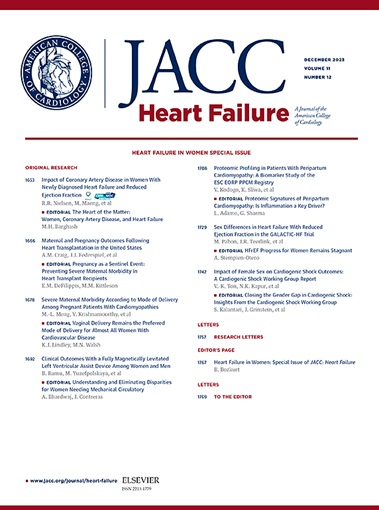Results of the Precision Event Monitoring for Patients With Heart Failure Using HeartLogic Study (PREEMPT-HF)
IF 10.3
1区 医学
Q1 CARDIAC & CARDIOVASCULAR SYSTEMS
引用次数: 0
Abstract
Background
Improved patient monitoring and management after heart failure (HF) hospitalizations are needed to reduce readmissions significantly.
Objectives
The aim of this study was to investigate the association between monitoring data and readmissions.
Methods
PREEMPT-HF (PRecision Event Monitoring for PatienTs with Heart Failure using HeartLogic) was a global, observational, single-arm study enrolling adult HF patients remotely monitored with HeartLogic-capable implantable cardioverter-defibrillator and cardiac resynchronization therapy devices. Patients and clinicians were blinded to the index and alerts. Participants were followed for 12 months for site reporting of events.
Results
A total of 2,155 patients were enrolled at 103 sites and were monitored remotely (39% implantable cardioverter-defibrillators and 61% cardiac resynchronization therapy-defibrillators). There were 243 hospitalizations for HF, of which 156 (64%) were index hospitalizations. There were 25 (28%) unplanned all-cause readmissions in the 30 days after discharge and 45 (46%) all-cause readmissions within 90 days. Alert sensitivity for outpatient visits and hospitalizations for HF was 78.3%, and the false-positive rate was 1.18/year. The HeartLogic index was higher before index hospitalizations for HF when followed by HF or readmission for all causes. Index hospitalizations for HF were also more likely to be followed by readmission for HF in 90 days if the patient was in an alert state (vs out-of-alert state) 1 or 2 weeks before or 2 weeks after the index admission.
Conclusions
HeartLogic index trends were significantly different for patients who were readmitted for HF. These trends suggest that individuals at risk for readmission have had a more sustained worsening and/or insufficient intervention during the initial hospitalization for HF. (PRecision Event Monitoring for PatienTs with Heart Failure using HeartLogic [PREEMPT-HF]; NCT03579641)
使用心脏逻辑研究(PREEMPT-HF)对心力衰竭患者进行精确事件监测的结果
背景:需要改善心衰(HF)住院后患者的监测和管理,以显著减少再入院。目的:本研究的目的是调查监测数据与再入院之间的关系。方法:PREEMPT-HF(使用HeartLogic对心力衰竭患者进行精确事件监测)是一项全球性的观察性单臂研究,纳入了使用HeartLogic功能的植入式心律转复除颤器和心脏再同步化治疗装置远程监测的成年心力衰竭患者。患者和临床医生对指数和警报不知情。研究人员对参与者进行了为期12个月的现场报道。结果:共纳入103个站点的2155例患者,并进行远程监测(39%采用植入式心律转复除颤器,61%采用心脏再同步治疗除颤器)。243例心衰住院,其中156例(64%)为指数住院。出院后30天内有25例(28%)非计划的全因再入院,90天内有45例(46%)全因再入院。HF的门诊和住院警示敏感性为78.3%,假阳性率为1.18/年。心衰住院前的HeartLogic指数高于随后的心衰或所有原因的再入院。如果患者在入院前1周或2周或入院后2周处于警戒状态(与非警戒状态相比),则因心力衰竭指数住院的患者更有可能在90天内再次因心力衰竭住院。结论:心衰再入院患者的HeartLogic指数趋势有显著差异。这些趋势表明,有再入院风险的个体在心力衰竭初次住院期间有更持续的恶化和/或干预不足。应用HeartLogic对心力衰竭患者的事件精确监测[PREEMPT-HF];NCT03579641)。
本文章由计算机程序翻译,如有差异,请以英文原文为准。
求助全文
约1分钟内获得全文
求助全文
来源期刊

JACC. Heart failure
CARDIAC & CARDIOVASCULAR SYSTEMS-
CiteScore
21.20
自引率
2.30%
发文量
164
期刊介绍:
JACC: Heart Failure publishes crucial findings on the pathophysiology, diagnosis, treatment, and care of heart failure patients. The goal is to enhance understanding through timely scientific communication on disease, clinical trials, outcomes, and therapeutic advances. The Journal fosters interdisciplinary connections with neuroscience, pulmonary medicine, nephrology, electrophysiology, and surgery related to heart failure. It also covers articles on pharmacogenetics, biomarkers, and metabolomics.
 求助内容:
求助内容: 应助结果提醒方式:
应助结果提醒方式:


